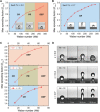Springtail-inspired superomniphobic surface with extreme pressure resistance
- PMID: 30151429
- PMCID: PMC6108567
- DOI: 10.1126/sciadv.aat4978
Springtail-inspired superomniphobic surface with extreme pressure resistance
Abstract
Both high static repellency and pressure resistance are critical to achieving a high-performance omniphobic surface. The cuticles of springtails have both of these features, which result from their hierarchical structure composed of primary doubly reentrant nanostructures on secondary microgrooves. Despite intensive efforts, none of the previous studies that were inspired by the springtail were able to simultaneously achieve both high static repellency and pressure resistance because of a general trade-off between these characteristics. We demonstrate for the first time a springtail-inspired superomniphobic surface displaying both features by fabricating a hierarchical system consisting of serif-T-shaped nanostructures on microscale wrinkles, overcoming previous limitations. Our biomimetic strategy yielded a surface showing high repellency to diverse liquids, from water to ethanol, with a contact angle above 150°. Simultaneously, the surface was able to endure extreme pressure resulting from the impacts of drops of water and of ethylene glycol with We >> 200, and of ethanol with We ~ 53, which is the highest pressure resistance ever reported. Overall, the omniphobicity of our springtail-inspired fabricated system was found to be superior to that of the natural springtail cuticle itself.
Figures





References
-
- Hensel R., Helbig R., Aland S., Voigt A., Neinhuis C., Werner C., Tunable nano-replication to explore the omniphobic characteristics of springtail skin. NPG Asia Mater. 5, e37 (2013).
-
- Hensel R., Neinhuis C., Werner C., The springtail cuticle as a blueprint for omniphobic surfaces. Chem. Soc. Rev. 45, 323–341 (2016). - PubMed
-
- Hensel R., Helbig R., Aland S., Braun H.-G., Voigt A., Neinhuis Christoph, Werner C., Wetting resistance at its topographical limit: The benefit of mushroom and serif T structures. Langmuir 29, 1100–1112 (2013). - PubMed
-
- Liu T., Kim C.-J., Turning a surface superrepellent even to completely wetting liquids. Science 346, 1096–1100 (2014). - PubMed
Publication types
LinkOut - more resources
Full Text Sources
Other Literature Sources

